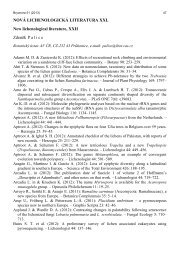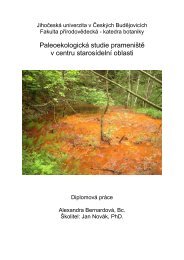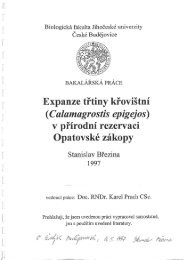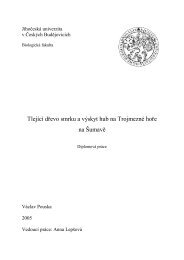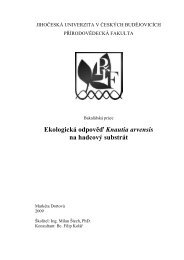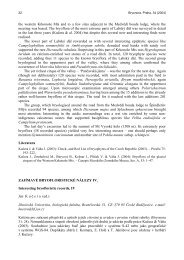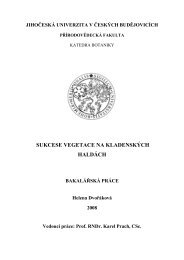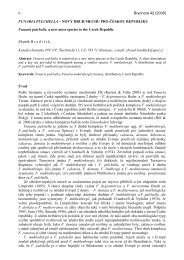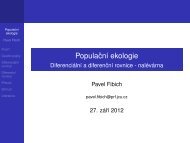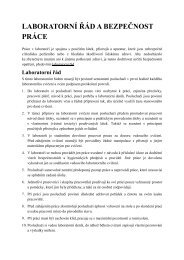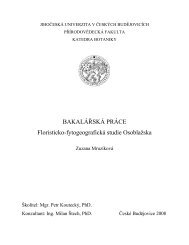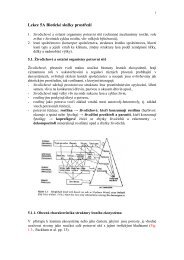Instructions for calculating indices of Functional Diversity with the file ...
Instructions for calculating indices of Functional Diversity with the file ...
Instructions for calculating indices of Functional Diversity with the file ...
Create successful ePaper yourself
Turn your PDF publications into a flip-book with our unique Google optimized e-Paper software.
<strong>Instructions</strong> <strong>for</strong> <strong>calculating</strong> <strong>indices</strong> <strong>of</strong><br />
<strong>Functional</strong> <strong>Diversity</strong> <strong>with</strong> <strong>the</strong> <strong>file</strong> “FunctDiv.xls”<br />
Last modified: May 2008<br />
Macro excel <strong>file</strong>: Jan (Šuspa) Lepš (suspa@prf.jcu.cz)<br />
Instruction manual: Francesco de Bello (fradebello@ctfc.es) & Jan Lepš<br />
If you use <strong>the</strong> excel <strong>file</strong> please cite it as:<br />
Lepš J., de Bello F., Lavorel S. & Berman S. (2006). Quantifying and<br />
interpreting functional diversity <strong>of</strong> natural communities: practical considerations<br />
matter. Preslia 78: 481–501<br />
The macro is freely available at: http://botanika.bf.jcu.cz/suspa/FunctDiv.php
In short<br />
What does <strong>the</strong> macro calculate?<br />
• <strong>the</strong> RAO index <strong>for</strong> species and functional trait diversity. The <strong>indices</strong> are<br />
calculated <strong>for</strong> each sample (e.g., alpha diversity; but <strong>the</strong> macro can be<br />
used to calculate also beta and gamma diversity)<br />
• different types <strong>of</strong> functional trait diversity <strong>indices</strong> based on Mason et al.<br />
(2005)<br />
• <strong>the</strong> trait community weighted means (trait mean per sample weighted by<br />
species relative abundance)<br />
• <strong>the</strong> relative abundance <strong>of</strong> species in a sample from a matrix <strong>of</strong> species x<br />
sample <strong>with</strong> <strong>the</strong> ‘absolute’ abundance <strong>of</strong> species.<br />
Which kind <strong>of</strong> data is needed?<br />
• a species x sample composition data <strong>with</strong> <strong>the</strong> occurrence or, better, <strong>the</strong><br />
abundance <strong>of</strong> each species x each sample (e.g. based on cover,<br />
biomass, nº <strong>of</strong> individuals etc..)<br />
• a trait x species matrix (details how to prepare this matrix are given in<br />
section 3).<br />
What kind <strong>of</strong> traits types can be handled?<br />
• quantitative traits (e.g. height, body size, leaf area) <strong>for</strong> which a mean and<br />
a standard deviation per each species is available (section 3.1)<br />
• categorical and binary traits (e.g. nitrogen fixer vs non-nitrogen fixer,<br />
color; see section 3.2 and 3.3). Binary traits are also used as semiquantitative<br />
variables <strong>for</strong> traits that have not been measured in <strong>the</strong> field<br />
(as taken by data bases, literature etc.). Dummy and fuzzy coding are<br />
allowed <strong>for</strong> <strong>the</strong>se trait types.<br />
• phenological and life cycle data (section 3.4)<br />
Biggest warnings<br />
• DO NOT CHANGE THE FILE NAME!!!! o<strong>the</strong>rwise <strong>the</strong> macro will not<br />
work any more (sorry!)<br />
• <strong>Diversity</strong> <strong>indices</strong> are sensible to <strong>the</strong> sampling method. It is strongly<br />
recommended to compare diversity <strong>indices</strong> in data sets where samples<br />
have been sampled <strong>with</strong> <strong>the</strong> same method (i.e. in term <strong>of</strong> sample area,<br />
species abundance measurement, <strong>for</strong> example cover or nº <strong>of</strong> individuals<br />
etc..)<br />
• For matrices <strong>with</strong> many species <strong>the</strong> calculation <strong>of</strong> trait dissimilarity<br />
and Rao index might take a while (a good excuse to boil some water<br />
<strong>for</strong> a tea!)<br />
<strong>Instructions</strong> <strong>for</strong> <strong>calculating</strong> <strong>indices</strong> <strong>of</strong> <strong>Functional</strong> <strong>Diversity</strong> <strong>with</strong> <strong>the</strong> <strong>file</strong> “FunctDiv.xls” 2
1. What is <strong>the</strong> macro about? What is functional diversity?<br />
The excel <strong>file</strong> “FunctDiv.exl” contains macros <strong>for</strong> <strong>the</strong> calculation <strong>of</strong> some <strong>of</strong> <strong>the</strong><br />
available <strong>indices</strong> <strong>of</strong> <strong>Functional</strong> <strong>Diversity</strong> (FD) in <strong>the</strong> literature (Mason et al.<br />
2005; Botta-Dukat 2005; Petchey & Gaston 2006; Lepš et al. 2006; de Bello et<br />
al. 2006, 2007, 2008). The <strong>indices</strong> that can be calculated take into account two<br />
types <strong>of</strong> data:<br />
(a) <strong>the</strong> species’ traits (i.e. ‘matrix species x traits’)<br />
(b) <strong>the</strong> species relative abundance in different samples/plots (i.e. ‘matrix<br />
species x sample’)<br />
This way, <strong>the</strong> <strong>indices</strong> calculated are thought to include in<strong>for</strong>mation on <strong>the</strong><br />
relative abundance <strong>of</strong> <strong>the</strong> species and do not calculate directly <strong>indices</strong> based<br />
only on species presence/absence (note: some tips on how to use this kind <strong>of</strong><br />
data are also given in <strong>the</strong> text).<br />
The macro has been originally prepared as an ad hoc tool <strong>for</strong> our personal<br />
needs (based on data mostly on plant and insect traits). As <strong>the</strong>re is not such<br />
material available yet, o<strong>the</strong>r colleagues asked us to use <strong>the</strong> <strong>file</strong> and we finally<br />
decided to make it available <strong>for</strong> everybody who might need it. We are conscious<br />
that <strong>the</strong> macro ‘not very sophisticated’ and ‘amateur’ from <strong>the</strong> es<strong>the</strong>tic point <strong>of</strong><br />
view and because it might not present a fancy user interface and <strong>the</strong><br />
programming approach is very simple. (Warning: Jan insisted that he learned<br />
some programming in late seventies using simple Basic coded using punched<br />
tape, and his programming skills might have not improved much from this time;<br />
he said that inspecting <strong>the</strong> code itself could cause hard attack to any person<br />
familiar <strong>with</strong> programming.)<br />
Never<strong>the</strong>less <strong>the</strong> macro works! We tested <strong>the</strong> functionality <strong>of</strong> <strong>the</strong> <strong>file</strong> <strong>with</strong><br />
several data sets and <strong>with</strong> some (courageous) colleagues working on plants,<br />
insects, birds and benthic invertebrates (thanks Marco, Marie, Christian,<br />
Sandra, Benoit, Karl etc). After some short introductions (as resumed in this<br />
text) we were able to obtain reasonable biological results in a short lap <strong>of</strong> time.<br />
Also <strong>the</strong> <strong>file</strong> runs on Excel, so most <strong>of</strong> <strong>the</strong> people can use it (even if it is not a<br />
free s<strong>of</strong>tware, sorry).<br />
Suggestions and constructive criticism are always welcome (see emails<br />
above)!!!<br />
<strong>Instructions</strong> <strong>for</strong> <strong>calculating</strong> <strong>indices</strong> <strong>of</strong> <strong>Functional</strong> <strong>Diversity</strong> <strong>with</strong> <strong>the</strong> <strong>file</strong> “FunctDiv.xls” 3
1.1. <strong>Functional</strong> <strong>Diversity</strong>: a biological issue<br />
The concept <strong>of</strong> functional diversity (FD) remains ra<strong>the</strong>r complex because <strong>the</strong>re<br />
are questions about how to define and measure it (Petchey and Gaston 2006).<br />
The <strong>Functional</strong> <strong>Diversity</strong>, <strong>for</strong> example can have different definitions. An<br />
approach that has gained currency considers <strong>the</strong> FD as “<strong>the</strong> extent <strong>of</strong> functional<br />
trait variation (or differences) among <strong>the</strong> species in a community” (Tilman 2001,<br />
Petchey and Gaston 2002) or, in o<strong>the</strong>r words, “<strong>the</strong> overall difference among<br />
species in a community in terms <strong>of</strong> <strong>the</strong>ir traits”. For example, two assemblages<br />
<strong>with</strong> a similar amount <strong>of</strong> species may be more or less functionally diverse<br />
depending on how similar/dissimilar <strong>the</strong> species’ traits are among <strong>the</strong> species in<br />
<strong>the</strong> communities. Some o<strong>the</strong>r researchers (e.g. Diaz & Cabido 2001; Diaz et al.<br />
2007) define functional diversity more broadly as <strong>the</strong> “kind, range and relative<br />
abundance <strong>of</strong> traits” (which include both <strong>indices</strong> <strong>of</strong> trait dissimilarity and<br />
community trait mean; see below). Here we use <strong>the</strong> first definition while also<br />
giving <strong>the</strong> tools to calculate all components mentioned by Diaz and colleagues.<br />
The FD is an important biological issue because is linked to <strong>the</strong> way space<br />
share <strong>the</strong> niche space available in a community (Mason et al. 2005) and have<br />
important consequences on <strong>the</strong> functioning <strong>of</strong> ecosystems (Diaz et al. 2007).<br />
Trait composition effects on ecosystem functioning can be assessed by<br />
<strong>calculating</strong> two main <strong>indices</strong> (a) trait community weighted mean (Garnier et al.<br />
2004; reflecting <strong>the</strong> mass ratio hypo<strong>the</strong>sis) and (b) functional diversity. Both<br />
such <strong>indices</strong> are calculated by <strong>the</strong> macro.<br />
1.2. <strong>Functional</strong> <strong>Diversity</strong> <strong>indices</strong>: basic ma<strong>the</strong>matics<br />
Two main <strong>indices</strong> <strong>of</strong> FD can be calculated by <strong>the</strong> <strong>file</strong> “FunctDiv.xls”:<br />
(a) <strong>the</strong> Rao index <strong>of</strong> diversity adapted <strong>for</strong> functional diversity (i.e. that uses<br />
species traits to calculate dissimilarity among species; Botta-Dukat 2005;<br />
Lepš et al. 2006; de Bello et al. 2008; Lavorel et al. 2008)<br />
(b) <strong>the</strong> index proposed by Mason and colleagues (2005), and modified by<br />
Leps et al. 2006, which reflects <strong>the</strong> overall variance <strong>of</strong> traits values in a<br />
community.<br />
The two <strong>indices</strong> have ra<strong>the</strong>r different <strong>for</strong>mulas but, preliminary results indicate<br />
that <strong>the</strong>ir variation along environmental gradients is comparable similar (de<br />
Bello et al. 2008). Here we give some details on <strong>the</strong> Rao index, mostly based<br />
on Lepš et al. 2006. Please see Mason et al. (2005) <strong>for</strong> details on <strong>the</strong> o<strong>the</strong>r<br />
index (however instructions to calculate <strong>the</strong> index are discussed here in section<br />
4).<br />
<strong>Instructions</strong> <strong>for</strong> <strong>calculating</strong> <strong>indices</strong> <strong>of</strong> <strong>Functional</strong> <strong>Diversity</strong> <strong>with</strong> <strong>the</strong> <strong>file</strong> “FunctDiv.xls” 4
The Rao coefficient presents several desirable properties <strong>for</strong> describing <strong>the</strong> FD<br />
<strong>of</strong> a community (see Ricotta 2005, Botta-Dukat 2005). In fact, it is a generalized<br />
<strong>for</strong>m <strong>of</strong> <strong>the</strong> Simpson index <strong>of</strong> diversity. If <strong>the</strong> proportion <strong>of</strong> i-th species in a<br />
community is pi (section 4.1 <strong>for</strong> details) and dissimilarity <strong>of</strong> species i and j is dij<br />
(section 3 <strong>for</strong> details), <strong>the</strong> Rao coefficient has <strong>the</strong> <strong>for</strong>m:<br />
s<br />
FD = d ij p i p j<br />
i=1 j=1<br />
where s is <strong>the</strong> number <strong>of</strong> species in <strong>the</strong> community and dij varies from 0 (two<br />
species have exatly <strong>the</strong> ! same traits) to 1 (<strong>the</strong> two species have completely<br />
different traits). If dij=1 <strong>for</strong> any pair <strong>of</strong> species (so each pair <strong>of</strong> species is<br />
completely different), <strong>the</strong>n FD is <strong>the</strong> Simpson index <strong>of</strong> diversity expressed as 1<br />
2<br />
minus Simpson index <strong>of</strong> dominance D, i.e. 1 " ! pi<br />
(see e.g., Botta-Dukat 2005<br />
i = 1<br />
<strong>for</strong> details).<br />
The Rao index generally reflects <strong>the</strong> probability that, picking randomly two<br />
individuals in a community (i.e. a sample), <strong>the</strong>y are different. For species<br />
diversity (i.e. <strong>the</strong> Simpson index <strong>of</strong> species diversity) this represents <strong>the</strong><br />
probability that <strong>the</strong> individuals are from different taxa. For trait diversity, <strong>the</strong> Rao<br />
index represents <strong>the</strong> probability that <strong>the</strong>y are functionally different (e.g. <strong>for</strong><br />
single traits, ei<strong>the</strong>r <strong>the</strong>y have different trait values or different trait categories).<br />
The Rao coefficient is very flexible, and can be used <strong>with</strong> various dissimilarity<br />
measures (<strong>for</strong> example, Shimatani 2001 used it <strong>with</strong> taxonomic dissimilarity;<br />
asymmetrical measures can be also used, etc.). The main methodological<br />
decisions are mainly how to measure <strong>the</strong> species dissimilarity, and how to<br />
characterize <strong>the</strong> proportion <strong>of</strong> a species in <strong>the</strong> community. The same decisions,<br />
however, have to be made even if we decide <strong>for</strong> o<strong>the</strong>r <strong>indices</strong> <strong>of</strong> functional<br />
diversity (details in Lepš et al. 2006).<br />
The species dissimilarity d, or also called ‘distance’, in <strong>the</strong> <strong>for</strong>mulas is computed<br />
in different ways depending on <strong>the</strong> trait type. For quantitative traits, <strong>the</strong> Overlap<br />
in <strong>the</strong> trait space among pairs <strong>of</strong> species is calculated (figure next page). The<br />
dissimilarity is expressed as 1 minus Overalp and thus it is scaled against<br />
between zero (no dissimilarity) and one (maximum dissimilarity). The user can<br />
use different types <strong>of</strong> data to calculate <strong>the</strong> dissimilarity between pair <strong>of</strong> species<br />
and should be aware on <strong>the</strong> basis by which this is calculated in <strong>the</strong> different<br />
type <strong>of</strong> data (see section 3 <strong>for</strong> details). There basically are four types <strong>of</strong> data<br />
that can be used to calculate <strong>with</strong> <strong>the</strong> macro in <strong>the</strong> FuncDiv <strong>file</strong>: (i) quantitative<br />
data (section 3.1), (ii) binary traits or continuous traits that range from zero to 1<br />
(section 3.2), (iii) categorial data <strong>with</strong> more than two levels coded as dummy<br />
variables (section 3.3)) and (iv) phonological and life cycle data (section 3.4).<br />
The case <strong>of</strong> quantitative values <strong>for</strong> species’ traits is <strong>the</strong> most ideal case, but not<br />
<strong>of</strong>ten possible <strong>the</strong> case (because it is more time consuming <strong>for</strong> field<br />
s<br />
"<br />
"<br />
<strong>Instructions</strong> <strong>for</strong> <strong>calculating</strong> <strong>indices</strong> <strong>of</strong> <strong>Functional</strong> <strong>Diversity</strong> <strong>with</strong> <strong>the</strong> <strong>file</strong> “FunctDiv.xls” 5<br />
S
measurements and because some traits are only categorical, e.g. legume vs<br />
non-legume). For quantitative traits, <strong>the</strong> overlap is calculated as showed in <strong>the</strong><br />
following figure (from Lepš et al. 2006: to calculate each curve <strong>the</strong> user needs<br />
<strong>the</strong> average <strong>for</strong> a given trait in every species and a measure <strong>of</strong> <strong>the</strong> Standard<br />
Deviation <strong>of</strong> this average).<br />
Please, note, that <strong>the</strong> standard deviation is a measure <strong>of</strong> variability between<br />
individuals <strong>with</strong>in a species, not <strong>the</strong> variability <strong>of</strong> <strong>the</strong> estimate (so, use standard<br />
deviation, not standard error <strong>of</strong> mean). In <strong>the</strong> macro, <strong>the</strong> probability density <strong>of</strong><br />
each species is approximated by a normal distribution, and <strong>the</strong>n, <strong>the</strong> integral <strong>of</strong><br />
<strong>the</strong> minimum value <strong>of</strong> <strong>the</strong> two compared probability density functions is<br />
calculated numerically (as a sum <strong>of</strong> very narrow rectangles!!).<br />
Finally, <strong>the</strong> FunctDiv.xls <strong>file</strong> calculates various versions <strong>of</strong> <strong>the</strong> Mason et al<br />
(2005) index. Because <strong>the</strong> Mason et al. index is in fact an algebraic function <strong>of</strong><br />
weighted standard deviation <strong>of</strong> log trans<strong>for</strong>med trait values, <strong>the</strong> macro enables<br />
calculation <strong>of</strong> <strong>the</strong> SD log trans<strong>for</strong>med trait values (weighted by <strong>the</strong> relative<br />
representation <strong>of</strong> <strong>the</strong> species) – macro “sdlog”. Because <strong>the</strong> log trans<strong>for</strong>mation<br />
is appropriate <strong>for</strong> some traits only (see Lepš et al. 2006), o<strong>the</strong>r macro<br />
(“sdnonlog”), calculates weighted standard deviation <strong>of</strong> original trait values.<br />
Also, to calculate <strong>the</strong>se <strong>indices</strong>, <strong>the</strong> macro calculates a community trait<br />
weighted mean (Garnier et al. 2004), which is a very important index <strong>of</strong><br />
functional trait composition that reflects components <strong>of</strong> <strong>the</strong> Mass Ratio<br />
Hypo<strong>the</strong>sis (Garnier et al. 2004). The index, <strong>with</strong> xi reflecting <strong>the</strong> trait mean <strong>for</strong> a<br />
given i-th species is as follows:<br />
!<br />
S<br />
"<br />
x = p i x i<br />
i=1<br />
<strong>Instructions</strong> <strong>for</strong> <strong>calculating</strong> <strong>indices</strong> <strong>of</strong> <strong>Functional</strong> <strong>Diversity</strong> <strong>with</strong> <strong>the</strong> <strong>file</strong> “FunctDiv.xls” 6
2. Steps in <strong>calculating</strong> <strong>the</strong> FD<br />
There are two basic steps in <strong>the</strong> calculation <strong>of</strong> <strong>the</strong> FD <strong>indices</strong>. First (section 3)<br />
<strong>the</strong> user will calculate <strong>the</strong> trait dissimilarity (i.e. dij) among all pair <strong>of</strong> species<br />
(this step is not needed <strong>for</strong> <strong>the</strong> Mason index, so just jump it if you are using this<br />
approach!). To calculate dij a different macro will be used depending on <strong>the</strong> type<br />
<strong>of</strong> data traits available (called, depending on <strong>the</strong> trait type used ‘disbin’,<br />
‘discateg’ and ‘disim’ and ‘phenol’). Then, (section 4), when <strong>the</strong> dissimilarity is<br />
calculated, <strong>the</strong> user will be able to calculate <strong>the</strong> desired FD <strong>with</strong> ano<strong>the</strong>r set <strong>of</strong><br />
macros (depending on <strong>the</strong> FD indeed needed).<br />
As commented above <strong>the</strong> user needs always two kinds <strong>of</strong> matrices to calculate<br />
<strong>the</strong> FD:<br />
(a) species x trait matrix (details in section 3)<br />
(b) species x sample matrix (details in section 4)<br />
3. Calculate <strong>the</strong> dissimilarity among species<br />
To compute <strong>the</strong> dissimilarity between every pair <strong>of</strong> species, <strong>the</strong> user has first to<br />
prepare an appropriate species x traits matrix. This matrix will include (see<br />
Example 1) <strong>the</strong> species name in <strong>the</strong> first column (<strong>the</strong> maximum species that<br />
can be considered to calculate species dissimilarity is at <strong>the</strong> moment limited to<br />
361 <strong>for</strong> <strong>the</strong> Rao index, not <strong>for</strong> Mason’s <strong>indices</strong>). The species name can be<br />
ei<strong>the</strong>r <strong>the</strong> real Latin-taxonomical name or any o<strong>the</strong>r type <strong>of</strong> label (no limits in<br />
characters is applied). In <strong>the</strong> o<strong>the</strong>r columns <strong>the</strong> user will introduce <strong>the</strong> traits info.<br />
As commented above <strong>the</strong> traits can be <strong>of</strong> different types, which correspond to<br />
using different sheets, different data inputs and different macros in <strong>the</strong> <strong>file</strong> (it is<br />
not so difficult as it sounds!).<br />
3.1. Quantitative traits<br />
Ideally <strong>the</strong> user have, <strong>for</strong> every species, a quantitative value <strong>for</strong> a given trait (as<br />
leaf area or body size) plus a standard deviation (SD) <strong>for</strong> this average (i.e.<br />
based on <strong>the</strong> measurements on <strong>the</strong> trait over several individuals; Cornellissen<br />
et al. 2003). For <strong>the</strong>se trait type he user will use <strong>the</strong> sheet “Data” and will<br />
introduce <strong>the</strong> data this way (see Example 1): two columns <strong>for</strong> every trait, being<br />
<strong>the</strong> first (i.e. left one) <strong>the</strong> trait value (e.g. in m 2 grams…whatever, <strong>the</strong> measure<br />
unit is not important) and, in <strong>the</strong> second (e.g. <strong>the</strong> right one), <strong>the</strong> SD <strong>for</strong> that trait<br />
<strong>for</strong> every species. In <strong>the</strong> case <strong>of</strong> several quantitative traits, <strong>the</strong> different couple<br />
<strong>of</strong> columns <strong>for</strong> every trait will follow one to <strong>the</strong> o<strong>the</strong>r. Here below an example <strong>of</strong><br />
how <strong>the</strong> traits should be introduced.<br />
<strong>Instructions</strong> <strong>for</strong> <strong>calculating</strong> <strong>indices</strong> <strong>of</strong> <strong>Functional</strong> <strong>Diversity</strong> <strong>with</strong> <strong>the</strong> <strong>file</strong> “FunctDiv.xls” 7
Example 1 (introduction <strong>of</strong> quantitative traits into <strong>the</strong> relative ‘Data’ sheet)<br />
Trait 1 (e.g. SLA here) and<br />
relative SD<br />
Then <strong>the</strong> user is ready to calculate <strong>the</strong> trait dissimilarity between all pair <strong>of</strong><br />
specie (<strong>the</strong> dissimilarity is calculated as shown in <strong>the</strong> figure in <strong>the</strong> section 1.2).<br />
The user should go to <strong>the</strong> excel command “Tools-Macro” (if English language is<br />
applied) and open <strong>the</strong> macro window as shown in <strong>the</strong> Example 2, chose <strong>the</strong><br />
macro called ‘disim’ and <strong>the</strong>n run <strong>the</strong> macro (click on “run”!). The macro will<br />
ask you in<strong>for</strong>mation on <strong>the</strong> number <strong>of</strong> species (8 in our example), and <strong>the</strong><br />
number <strong>of</strong> traits (called “variables”; 2 in our example).<br />
Example 2 (running <strong>the</strong> macro ‘disim’ <strong>with</strong> quantitative traits)<br />
2. “run” <strong>the</strong> macro (‘Ejecutar’ in<br />
Spanish!)<br />
Use “Data” sheet!<br />
1. select macro “disim”<br />
Trait 2 (e.g. height here) and<br />
relative SD (sorry <strong>for</strong> <strong>the</strong><br />
typo!!)<br />
After <strong>the</strong> macro is run, <strong>the</strong> results are displayed in <strong>the</strong> sheet “spesim” as<br />
shown in <strong>the</strong> Example 3. The values range from 0 (no dissimilarity between a<br />
given pair <strong>of</strong> species) 1 (maximum dissimilarity). For example, <strong>the</strong> dissimilarity<br />
between sp1 and sp2 <strong>for</strong> SLA is 1 (i.e. no overlap, complete functional<br />
<strong>Instructions</strong> <strong>for</strong> <strong>calculating</strong> <strong>indices</strong> <strong>of</strong> <strong>Functional</strong> <strong>Diversity</strong> <strong>with</strong> <strong>the</strong> <strong>file</strong> “FunctDiv.xls” 8
difference) while <strong>the</strong> dissimilarity between sp4 and sp7 (line 22 in this case) is<br />
0.35 (see circles in <strong>the</strong> Example 3; 0.35 means that, in <strong>the</strong> field, <strong>the</strong>se two<br />
species are functionally identically <strong>for</strong> SLA in 35% <strong>of</strong> <strong>the</strong> cases). The user might<br />
decide to copy all <strong>the</strong>se results in a separate <strong>file</strong> <strong>for</strong> fur<strong>the</strong>r controls or <strong>for</strong> o<strong>the</strong>r<br />
analysis he/she might be interested to do <strong>with</strong> dissimilarity (see Petchey &<br />
Gaston 2006). Note, in fact, that each time trait dissimilarity is calculated, <strong>the</strong><br />
new results are overwritten on <strong>the</strong> old ones. The macro also calculates <strong>the</strong><br />
average dissimilarity between pairs <strong>of</strong> species in terms <strong>of</strong> all traits toge<strong>the</strong>r (see<br />
Example 3). Note that <strong>the</strong> program does not report <strong>the</strong> original species names<br />
introduced in <strong>the</strong> “data” sheet.<br />
Example 3 (results <strong>of</strong> dissimilarity between all pair <strong>of</strong> species in <strong>the</strong> ‘spesim’<br />
sheet)<br />
Average <strong>of</strong> <strong>the</strong> traits<br />
dissimilarity in terms <strong>of</strong> <strong>the</strong> 2<br />
traits toge<strong>the</strong>r (i.e. average <strong>of</strong><br />
columns c-d)<br />
3.2. Binary and continuous traits scaled between 0 and 1<br />
Results <strong>of</strong> species<br />
dissimilarities are shown in<br />
<strong>the</strong> sheet “spesim”<br />
The most common case <strong>for</strong> which trait in<strong>for</strong>mation is available is when <strong>the</strong> user<br />
has traits taken from flora, fauna books and/or databases. In this case, to use<br />
<strong>the</strong> FunctDiv <strong>file</strong>, we propose to trans<strong>for</strong>m all trait into a value by scaling it<br />
between 0 and 1. This will apply to (a) binary traits or (b) continuous trait. Let’s<br />
see some examples to be clearer.<br />
The case <strong>of</strong> binary traits is, <strong>for</strong> example, when an animal species “has” or “does<br />
not have” wings” or a plant “can” or “cannot” fix nitrogen (as ‘legume’ in<br />
Example 4). In this case <strong>the</strong> user has ei<strong>the</strong>r zero or 1. For this trait type, <strong>the</strong><br />
dissimilarity between pair <strong>of</strong> species is 1 when <strong>the</strong> two species are from<br />
different groups (one is coded “0” and <strong>the</strong> o<strong>the</strong>r one “1”) and 0 when <strong>the</strong>y are<br />
not different (see results in Example 6). Note that <strong>for</strong> some apparently strange<br />
<strong>Instructions</strong> <strong>for</strong> <strong>calculating</strong> <strong>indices</strong> <strong>of</strong> <strong>Functional</strong> <strong>Diversity</strong> <strong>with</strong> <strong>the</strong> <strong>file</strong> “FunctDiv.xls” 9
(‘crazy’ might be <strong>the</strong> best word here; but actually just <strong>for</strong> being pragmatic, see<br />
below) each trait needs to be characterized by two headers. There<strong>for</strong>e every<br />
trait (columns) will be characterized by a two lines (headers) repeating <strong>the</strong> same<br />
in<strong>for</strong>mation (changing this will alter <strong>the</strong> results, see below).<br />
Example 4 (introduction <strong>of</strong> binary and continuous traits in <strong>the</strong> Binary sheet)<br />
Two headers <strong>for</strong> every traits<br />
(reasons explained in<br />
Examples 7 –8)<br />
Use <strong>the</strong> “Binary” sheet<br />
In <strong>the</strong> same ‘binary’ sheet <strong>the</strong> user can introduce semi-quantitative traits that<br />
need to be scaled between zero and 1 (as ‘height’ or ‘leaf area’ in Example 4).<br />
This is a way to deal <strong>with</strong> quantitative traits <strong>for</strong> which we have not measured <strong>the</strong><br />
standard errors (this is <strong>the</strong> case, <strong>for</strong> example, <strong>of</strong> <strong>the</strong> size or plant height or body<br />
size taken from flora/fauna books). To resolve this, <strong>the</strong> traits should be scaled<br />
from zero (minimum value in <strong>the</strong> data set) and 1 (maximum value). For<br />
example, if <strong>the</strong> minimum plant height in <strong>the</strong> data set is 10 cm and <strong>the</strong> maximum<br />
is 110 cm, <strong>the</strong>n any o<strong>the</strong>r height (e.g. 60 cm) could be scaled somehow in this<br />
range (e.g. it can give 0.5). Logarithmic scales can be used to calculate such<br />
proportions. The dissimilarity in this case is calculated as <strong>the</strong> difference<br />
between two species. For example, if <strong>the</strong> trait is height and we have two<br />
species having 0.35 (species 1, Example 4) and 0.75 (species 2, Example 4),<br />
<strong>the</strong> dissimilarity will be 0.4 (Example 6).<br />
When <strong>the</strong> data is well introduced into <strong>the</strong> “binary” sheet, <strong>the</strong> user is ready to<br />
calculate <strong>the</strong> trait dissimilarity between all pair <strong>of</strong> specie. The user should go, as<br />
shown in <strong>the</strong> section 3.1 and example 2) to <strong>the</strong> excel command “Tools-Macro”<br />
and open <strong>the</strong> macro window (as shown in <strong>the</strong> Example 5), chose <strong>the</strong> macro<br />
called “disibin” and <strong>the</strong>n run <strong>the</strong> macro (click on “run”!). The macro will ask you<br />
again <strong>the</strong> in<strong>for</strong>mation on <strong>the</strong> number <strong>of</strong> species (always 8 in our example), but<br />
this time it will understand automatically how many traits are available (indeed<br />
an intelligent machine!). As a matter <strong>of</strong> fact <strong>the</strong> macro will automatically count<br />
<strong>the</strong> number <strong>of</strong> different traits, by looking at <strong>the</strong> number <strong>of</strong> columns <strong>with</strong> different<br />
header in <strong>the</strong> first row. That’s one <strong>of</strong> <strong>the</strong> reasons why <strong>the</strong> two headers are<br />
needed.<br />
<strong>Instructions</strong> <strong>for</strong> <strong>calculating</strong> <strong>indices</strong> <strong>of</strong> <strong>Functional</strong> <strong>Diversity</strong> <strong>with</strong> <strong>the</strong> <strong>file</strong> “FunctDiv.xls” 10
Example 5 (<strong>calculating</strong> <strong>the</strong> dissimilarity <strong>for</strong> binary and continuous traits using<br />
<strong>the</strong> ‘disbin’ macro)<br />
After <strong>the</strong> macro was run, <strong>the</strong> results will be displayed in <strong>the</strong> sheet “spesim”<br />
(Example 6). Note that, each time, a different macro (ei<strong>the</strong>r disbin, discateg<br />
or disim) is used to calculate <strong>the</strong> dissimilarity between species, <strong>the</strong> data<br />
are overwritten in <strong>the</strong> specsim sheet. So it is better to keep this clean.<br />
In <strong>the</strong> results (Example 6). The values range from 0 (no dissimilarity between a<br />
given pair <strong>of</strong> species) 1 (maximum dissimilarity). In this case, <strong>the</strong> macro DOES<br />
NOT calculate <strong>the</strong> average dissimilarity between all pairs <strong>of</strong> species in terms <strong>of</strong><br />
all traits toge<strong>the</strong>r (as in Example 3).<br />
Example 6 (results <strong>of</strong> dissimilarity)<br />
2. “run” <strong>the</strong> macro (Ejecutar in<br />
Spanish!)<br />
1. select macro “disbin”<br />
The average <strong>of</strong> <strong>the</strong> traits<br />
dissimilarity is NOT<br />
automatically calculated (as it<br />
was in <strong>the</strong> Example 3; see<br />
example 7 and 8 <strong>for</strong> <strong>the</strong><br />
reasons)<br />
Results <strong>of</strong> species dissimilarities<br />
are always shown in<br />
<strong>the</strong> sheet “spesim”<br />
<strong>Instructions</strong> <strong>for</strong> <strong>calculating</strong> <strong>indices</strong> <strong>of</strong> <strong>Functional</strong> <strong>Diversity</strong> <strong>with</strong> <strong>the</strong> <strong>file</strong> “FunctDiv.xls” 11
The reason <strong>of</strong> <strong>the</strong> presence <strong>of</strong> two headers <strong>for</strong> every column (and <strong>for</strong> <strong>the</strong><br />
absence <strong>of</strong> automatically calculated averages) is because <strong>the</strong> user, by<br />
changing <strong>the</strong> first header can change <strong>the</strong> way <strong>the</strong> dissimilarity is calculated. If,<br />
following <strong>the</strong> Example 4-6, he/she puts <strong>the</strong> same header to “height” and “leaf<br />
area” in <strong>the</strong> first row (<strong>for</strong> example calling it “plantsize”) <strong>the</strong> user will be able to<br />
calculate directly <strong>the</strong> dissimilarity <strong>for</strong> <strong>the</strong> two traits toge<strong>the</strong>r (Examples 7-8).<br />
Example 7 (changes in <strong>the</strong> headers change <strong>the</strong> calculations)<br />
Example 8 (changes in <strong>the</strong> headers change <strong>the</strong> calculations and <strong>the</strong> way <strong>the</strong><br />
results are shown)<br />
3.3. Categorical traits coded as dummy variables<br />
The two traits have now <strong>the</strong><br />
same header in <strong>the</strong> first row<br />
0.3 is <strong>the</strong> average <strong>of</strong> <strong>the</strong><br />
dissimilarity <strong>for</strong> plant height<br />
and leaf area <strong>of</strong> <strong>the</strong> example<br />
6, i. e. (0.4+0.2)/2<br />
The user might also introduce that data <strong>for</strong> categorial (=nominal) traits <strong>with</strong><br />
more than two categories, coded as several dummy variables (Example 9). For<br />
example <strong>the</strong> color <strong>of</strong> a flower can be yellow-black-red-blue. This gives four<br />
categories. So <strong>the</strong> user should build <strong>the</strong> traits as four columns where, <strong>for</strong> each<br />
species (row), <strong>the</strong> sum must be 1 (<strong>for</strong> example if <strong>the</strong> flower is blue, <strong>the</strong>n he/she<br />
will put one to <strong>the</strong> column <strong>for</strong> blue flower and zero <strong>for</strong> o<strong>the</strong>r colors). A special<br />
case <strong>of</strong> dummy variables is <strong>the</strong> use <strong>of</strong> fuzzy coding. If we have, <strong>for</strong> example, a<br />
flower that is half red and half blue we can code 0.5 <strong>for</strong> <strong>the</strong> “red” column and<br />
0.5 <strong>for</strong> <strong>the</strong> “blue” one, and zero <strong>for</strong> <strong>the</strong> o<strong>the</strong>r categories. If we have ano<strong>the</strong>r trait<br />
as life <strong>for</strong>m <strong>for</strong> plants (GF in Example 9), a plant that can behave ei<strong>the</strong>r as<br />
hemicriptophyte and chamaephyte will have 0.5 <strong>for</strong> both categories. The user<br />
will use <strong>the</strong> excel sheet “categories” <strong>for</strong> <strong>the</strong>se kind <strong>of</strong> data. In <strong>the</strong> matrix a<br />
different header <strong>for</strong> every trait should be given in <strong>the</strong> first row, while on <strong>the</strong><br />
second <strong>the</strong>re are <strong>the</strong> names <strong>of</strong> <strong>the</strong> categories in which <strong>the</strong> traits are divided<br />
(see Example 9).<br />
<strong>Instructions</strong> <strong>for</strong> <strong>calculating</strong> <strong>indices</strong> <strong>of</strong> <strong>Functional</strong> <strong>Diversity</strong> <strong>with</strong> <strong>the</strong> <strong>file</strong> “FunctDiv.xls” 12
Example 9 (introduction <strong>of</strong> dummy traits)<br />
The first header is <strong>the</strong> trait type (e.g. flower color)<br />
The second refers to <strong>the</strong> categories <strong>of</strong> <strong>the</strong> trait<br />
Use <strong>the</strong> “Categories” sheet<br />
The total per<br />
species <strong>for</strong> a<br />
given trait is 1<br />
When <strong>the</strong> data is introduced in <strong>the</strong> “Categories” sheet, <strong>the</strong> user is ready to<br />
calculate <strong>the</strong> dissimilarity between all pair <strong>of</strong> specie. The user should go to <strong>the</strong><br />
excel command “Tools-Macro” and open <strong>the</strong> macro window as shown in <strong>the</strong><br />
Example 2 and 5 (<strong>for</strong> <strong>the</strong> o<strong>the</strong>r macros), chose <strong>the</strong> macro called “disicateg”<br />
and <strong>the</strong>n run <strong>the</strong> macro (click on “run”!). The macro will ask you in<strong>for</strong>mation on<br />
<strong>the</strong> number <strong>of</strong> species (8 in our example). The macro will automatically count<br />
<strong>the</strong> number <strong>of</strong> traits, by <strong>the</strong> number <strong>of</strong> colums <strong>with</strong> different header in <strong>the</strong> first<br />
row. The basic difference between this macro (i.e.”disicateg” using data in <strong>the</strong><br />
“Categories” spreadsheet) from <strong>the</strong> “Binary” data (macro “disibin”, section 3.2)<br />
is that, <strong>with</strong> ‘disicateg’, <strong>the</strong> values in columns belonging to a single trait MUST<br />
sum up to one <strong>for</strong> a species. Consequently, <strong>the</strong> dissimilarity <strong>for</strong> species one and<br />
two <strong>for</strong> a trait is calculated as (∑i(x1,i-x2,i))/2 (i is <strong>the</strong> category index) . The<br />
resulting value is one, if <strong>the</strong> two species do not share any trait. For crisp<br />
classification, <strong>the</strong> values are ei<strong>the</strong>r 0 or 1, <strong>for</strong> fuzzy classification, <strong>the</strong> values<br />
range between 0 and 1 (see results in Example 10)<br />
Example 10 (some <strong>of</strong> <strong>the</strong> results <strong>of</strong> dissimilarity <strong>for</strong> dummy traits in <strong>the</strong> spesim<br />
sheet)<br />
<strong>Instructions</strong> <strong>for</strong> <strong>calculating</strong> <strong>indices</strong> <strong>of</strong> <strong>Functional</strong> <strong>Diversity</strong> <strong>with</strong> <strong>the</strong> <strong>file</strong> “FunctDiv.xls” 13
3.4. Phenological and life cycle data<br />
Sometimes, <strong>the</strong> user have data which can be defined as ‘circular’, i.e. <strong>the</strong><br />
starting flowering date in a plant (or a trait defined by some inclination or angle).<br />
How to calculate <strong>the</strong> dissimilarity between two species flowering one in<br />
December and <strong>the</strong> o<strong>the</strong>r one in January? If we count <strong>the</strong> number <strong>of</strong> months<br />
(12 th and 1 st ) in <strong>the</strong> year <strong>the</strong> dissimilarity will wrongy be estimated (11). We can<br />
thus introduce in ano<strong>the</strong>r sheet (“phenolog”) data similar on plant flowering<br />
period (or corners, life cycle). This sheet calculates <strong>the</strong> dissimilarity between<br />
pair <strong>of</strong> species as 1 - (number <strong>of</strong> days when both <strong>the</strong> species flower<br />
toge<strong>the</strong>r/number <strong>of</strong> days during which at least one <strong>of</strong> <strong>the</strong>m is flowering).<br />
This value might be site specific. To introduce <strong>the</strong> data <strong>the</strong> user should thus<br />
have data <strong>of</strong> <strong>the</strong> Julian day when each species is starting and ending <strong>the</strong><br />
flowering, and introduce <strong>the</strong> data as shown in <strong>the</strong> Example 11. Most detailed<br />
reason why such kind <strong>of</strong> data should not be calculated as simple quantitative<br />
values is discussed in Leps et al. 2006. The macro runs similarly to macro<br />
presented in section 3.1, 3.2 and 3.3 and <strong>the</strong> result <strong>of</strong> species dissimilarity will<br />
be also displayed in <strong>the</strong> working sheet “spesim”.<br />
Example 12 (Introducing data on plant flowering period (‘from’ = starting julian<br />
day; ‘to’ ending day) in <strong>the</strong> ‘phenolog’ sheet).<br />
Use sheet ‘phenolog’<br />
and “phenol” macro<br />
Example 13 (results from <strong>the</strong> macro ‘phenol’ shown in <strong>the</strong> spesim sheet)<br />
<strong>Instructions</strong> <strong>for</strong> <strong>calculating</strong> <strong>indices</strong> <strong>of</strong> <strong>Functional</strong> <strong>Diversity</strong> <strong>with</strong> <strong>the</strong> <strong>file</strong> “FunctDiv.xls” 14
4. Calculate <strong>the</strong> <strong>Functional</strong> <strong>Diversity</strong><br />
Once <strong>the</strong> user has calculated <strong>the</strong> dissimilarity among species’ traits (needed<br />
only <strong>for</strong> <strong>the</strong> Rao index), most <strong>of</strong> <strong>the</strong> work has already been done (congratulation<br />
<strong>for</strong> surviving this difficult step, if we meet someday remind us to invite you <strong>for</strong> a<br />
beer or <strong>the</strong> preferred non-alcoholic drink)!! Be<strong>for</strong>e doing <strong>the</strong> final step<br />
(<strong>calculating</strong> <strong>the</strong> FD), <strong>the</strong> user should now introduce a species x sample matrix<br />
and be conscious <strong>of</strong> <strong>the</strong> different possibilities he/she has here and <strong>the</strong> various<br />
implications <strong>of</strong> <strong>the</strong> choice.<br />
4.1. Species x plot matrix<br />
This is <strong>the</strong> matrix where <strong>the</strong> user says in which samples (or sometimes also<br />
called/defined as “plots” or “communities”) he found <strong>the</strong> species and in which<br />
abundance <strong>the</strong>y were in each sample. If we take <strong>the</strong> 8 species <strong>of</strong> <strong>the</strong> previous<br />
examples we can introduce <strong>the</strong>ir abundance in <strong>the</strong> appropriate sheets. Ideally<br />
<strong>the</strong> macros <strong>for</strong> Rao and Mason indexes need <strong>the</strong> in<strong>for</strong>mation <strong>of</strong> pi (see <strong>for</strong><br />
example <strong>the</strong> Rao FD <strong>for</strong>mula at page 4 and <strong>the</strong> Simpson index <strong>of</strong> species<br />
diversity at page 5), which is <strong>the</strong> relative abundance <strong>of</strong> species in a plot (this<br />
means that <strong>the</strong> total <strong>for</strong> every sample should sum 1; see Example 14). To<br />
calculate <strong>the</strong> relative frequency <strong>the</strong> user should consider <strong>the</strong> following. In<br />
general, <strong>the</strong> users have a “ni” e.g. <strong>the</strong> number <strong>of</strong> individuals (or number <strong>of</strong><br />
contacts, biomass, or what ever measure <strong>of</strong> species abundance) <strong>for</strong> every i-th<br />
species in <strong>the</strong> sample. Then sum <strong>of</strong> <strong>the</strong> “n” <strong>of</strong> all <strong>the</strong> species gives “N”, i.e. <strong>the</strong><br />
sum <strong>the</strong> total number <strong>of</strong> individuals <strong>for</strong> a given sample. The relative abundance<br />
<strong>for</strong> a given i-th species is ni/N, dividing <strong>the</strong> number <strong>of</strong> individuals <strong>for</strong> a given<br />
species <strong>for</strong> N (<strong>for</strong> example, if <strong>the</strong> species1 has 25 individuals, or grams, in<br />
sample1 and N is 100, <strong>the</strong>n <strong>the</strong> relative abundance is 0.25; see Example 14<br />
and 15). The user that wants to use <strong>the</strong> <strong>for</strong>mula <strong>for</strong> FD <strong>for</strong> presence/absence<br />
data (i.e. no measure <strong>of</strong> species abundance are available or <strong>the</strong> user does not<br />
want to consider <strong>the</strong>m), can solve this by introduce <strong>the</strong> same value <strong>for</strong> <strong>the</strong><br />
species abundance <strong>for</strong> all species present in a sample (<strong>with</strong> <strong>the</strong> total always<br />
summing 1). This is <strong>the</strong> case <strong>for</strong> example <strong>of</strong> column B (Sample1 <strong>with</strong> 4 species<br />
¼=0.25) in <strong>the</strong> Example 14:<br />
Example 14 (example <strong>of</strong> <strong>the</strong> species x sample matrix having, <strong>for</strong> each species<br />
and plot a given relative abundance. The total <strong>for</strong> each column need to be = 1)<br />
The sum <strong>for</strong> every<br />
column (sample) is 1<br />
This case mimics<br />
presence/absence data (all<br />
species have <strong>the</strong> same<br />
relative abundance)<br />
Use “relative” sheet<br />
<strong>Instructions</strong> <strong>for</strong> <strong>calculating</strong> <strong>indices</strong> <strong>of</strong> <strong>Functional</strong> <strong>Diversity</strong> <strong>with</strong> <strong>the</strong> <strong>file</strong> “FunctDiv.xls” 15
Very <strong>of</strong>ten <strong>the</strong> users don’t have ready-made data <strong>of</strong> species relative abundance<br />
but ra<strong>the</strong>r “absolute” values (i.e. <strong>with</strong> “ni”). This is <strong>the</strong> case <strong>of</strong> having rough data<br />
<strong>of</strong>, e.g., <strong>the</strong> number <strong>of</strong> individuals, or biomass, or cover <strong>for</strong> each species. To<br />
make life easier a macro (i.e. ‘relativize’) was added to <strong>the</strong> <strong>file</strong> to calculate<br />
directly <strong>the</strong> relative abundance <strong>of</strong> species from <strong>the</strong> ‘absolute’ abundance <strong>of</strong><br />
species. For this, <strong>the</strong> “absolute” data need to be introduced in <strong>the</strong> “Absolute”<br />
sheet and <strong>the</strong> user need to run <strong>the</strong> macro called “relativize” (see Example 15).<br />
Example 15 (trans<strong>for</strong>ming <strong>the</strong> absolute abundance <strong>of</strong> species to relative<br />
abundance, i.e. pi always needed <strong>for</strong> FD Rao, Simpson, Mason <strong>indices</strong> and <strong>the</strong><br />
community weig<strong>the</strong>d trait mean. Put <strong>the</strong> data into <strong>the</strong> “Absolute” sheet and use<br />
macro “relativize”)<br />
Put <strong>the</strong> abundance <strong>of</strong><br />
species measured as, e.g.,<br />
nº <strong>of</strong> individuals, biomass<br />
etc. in <strong>the</strong> “Absolute” sheet<br />
Convert <strong>the</strong> absolute<br />
abundance (ni) <strong>of</strong><br />
species to relative<br />
abundance (i.e. pi)<br />
<strong>with</strong> <strong>the</strong> macro<br />
“relativize”<br />
The user should be aware that different measures <strong>of</strong> species abundance give a<br />
different weight to <strong>the</strong> dominant species in a community (see details in Lepš et<br />
al. 2006; de Bello et al. 2007). There are three main common ways to quantify<br />
<strong>the</strong> relative abundance <strong>of</strong> species in communities: counts <strong>of</strong> individuals<br />
(population density), frequency or cover estimates, and biomass (<strong>the</strong>n each<br />
measure can be trans<strong>for</strong>med, e.g. log-trans<strong>for</strong>med, also affecting dominance <strong>of</strong><br />
species; de Bello et al. 2007). It is well known to field ecologists that <strong>the</strong>se<br />
quantities are not equivalent. An important difference between biomass- and<br />
frequency-based calculations <strong>of</strong> relative abundances is that evenness in <strong>the</strong><br />
<strong>for</strong>mer is usually lower than in <strong>the</strong> latter (usually much lower when <strong>the</strong><br />
frequency is based on large basic sampling units). It is hence not uncommon <strong>for</strong><br />
5-10 species, if not fewer, to make up <strong>the</strong> majority <strong>of</strong> <strong>the</strong> biomass (e.g. 80%),<br />
while a larger number <strong>of</strong> species (10-20) may be needed to achieve <strong>the</strong> same<br />
threshold on a frequency basis (particularly when using relatively large basic<br />
sampling units). Similarly, <strong>the</strong> biomass values (and also <strong>the</strong> number <strong>of</strong><br />
individuals in animal studies) vary over several orders <strong>of</strong> magnitude among<br />
species, whereas <strong>the</strong> cover varies less and frequency even less. The way <strong>of</strong><br />
quantifying species’ relative abundances has thus important consequences <strong>for</strong><br />
calculations <strong>of</strong> compound diversity (including functional diversity) <strong>indices</strong><br />
because “artificially” <strong>the</strong> evenness <strong>of</strong> a community.<br />
<strong>Instructions</strong> <strong>for</strong> <strong>calculating</strong> <strong>indices</strong> <strong>of</strong> <strong>Functional</strong> <strong>Diversity</strong> <strong>with</strong> <strong>the</strong> <strong>file</strong> “FunctDiv.xls” 16
Example 16: (Effect <strong>of</strong> different measures <strong>of</strong> species abundance on <strong>the</strong> relative<br />
abundance <strong>of</strong> <strong>the</strong> species. The example shows <strong>the</strong> species’ ranking <strong>for</strong> an<br />
hypo<strong>the</strong>tical community where <strong>the</strong> user uses <strong>the</strong> count <strong>of</strong> individuals or <strong>the</strong><br />
biomass <strong>for</strong> plants (maximum importance to most abundant species), <strong>the</strong><br />
frequency or cover and <strong>the</strong> case where all <strong>the</strong> species have <strong>the</strong> same<br />
abundance (only presence/absence data considered), which mimics <strong>the</strong> highest<br />
evenness).<br />
As <strong>the</strong> FD <strong>indices</strong> in <strong>the</strong> macro use <strong>the</strong> relative abundance <strong>of</strong> <strong>the</strong> species (pi), it<br />
is clear that a different weight to <strong>the</strong> traits <strong>of</strong> <strong>the</strong> dominant species (more when<br />
<strong>the</strong> species-rank curves are less flat) and subordinate species. Different<br />
measure <strong>of</strong> <strong>the</strong> species relative frequency gives ra<strong>the</strong>r different values <strong>for</strong> a<br />
given community (de Bello et al. 2007). From preliminary observation we<br />
observed that <strong>the</strong> more dominance we have in a sample <strong>the</strong> more is <strong>the</strong> chance<br />
to have species (i.e. Simpson) and functional diversity calculated <strong>with</strong> <strong>the</strong> Rao<br />
index are correlated.<br />
<strong>Instructions</strong> <strong>for</strong> <strong>calculating</strong> <strong>indices</strong> <strong>of</strong> <strong>Functional</strong> <strong>Diversity</strong> <strong>with</strong> <strong>the</strong> <strong>file</strong> “FunctDiv.xls” 17
4.2. Calculate <strong>the</strong> FD <strong>indices</strong> (finally!!!!)<br />
To finally calculate <strong>the</strong> Rao FD <strong>for</strong> each sample, <strong>the</strong> user will use <strong>the</strong> results <strong>of</strong><br />
<strong>the</strong> dissimilarity among species (those that are in <strong>the</strong> “spesim” sheet, e.g. <strong>the</strong><br />
ones <strong>for</strong> <strong>the</strong> Example 3, <strong>for</strong> quantitative traits), and <strong>the</strong> data on <strong>the</strong> page <strong>of</strong> <strong>the</strong><br />
relative abundance <strong>of</strong> <strong>the</strong> species (those that are in <strong>the</strong> “relative” sheet<br />
Example 14; Note that <strong>for</strong> <strong>the</strong> RAO index, <strong>the</strong> data in <strong>the</strong> o<strong>the</strong>r sheets are<br />
not used; <strong>for</strong> <strong>the</strong> Mason index <strong>the</strong> sheet used are ‘data’ and ‘relative’).<br />
THE RAO index<br />
The user should go to <strong>the</strong> excel command “Tools-Macro” and open <strong>the</strong> macro<br />
window as shown in <strong>the</strong> Example 17. Then he/she should select <strong>the</strong> desired<br />
FD index. By choosing <strong>the</strong> macro called “FDindex”, and <strong>the</strong>n run <strong>the</strong> macro<br />
(click on “run”!), <strong>the</strong> user will calculate <strong>the</strong> Rao index <strong>of</strong> diversity. The macro will<br />
ask you in<strong>for</strong>mation on <strong>the</strong> number <strong>of</strong> species (8 in our example), <strong>the</strong> number <strong>of</strong><br />
samples (also 4 in our example). The user will be asked also about some<br />
crazy in<strong>for</strong>mation, i.e. <strong>the</strong> number <strong>of</strong> <strong>the</strong> column where <strong>the</strong> dissimilarity<br />
starts in <strong>the</strong> sheet “spesim” and <strong>the</strong> ending column (Example 18). This<br />
means, from our Example 3, <strong>with</strong> two traits, that <strong>the</strong> dissimilarity <strong>for</strong> <strong>the</strong> first<br />
traits was on column C (<strong>the</strong> third column) so that <strong>the</strong> “dissimilarity starting<br />
column” is equal to 3 (<strong>the</strong> first two columns refer to species identity; please note<br />
<strong>the</strong> starting column will be always <strong>the</strong> third in <strong>the</strong> ‘spesim’ sheet, but <strong>the</strong> user<br />
might be interested to use only some traits starting from ano<strong>the</strong>r column) and<br />
<strong>the</strong> ending column is where is <strong>the</strong> last trait (column E, i.e. 5 th column; i.e.<br />
dissimilarity ending column in equal to 5 in <strong>the</strong> example; note that in <strong>the</strong><br />
Example 3 <strong>the</strong> column E is <strong>the</strong> average <strong>of</strong> <strong>the</strong> columns C-D, so E is <strong>the</strong><br />
dissimilarity <strong>for</strong> two traits toge<strong>the</strong>r).<br />
Example 17 (ready to calculate <strong>the</strong> FD!)<br />
Select <strong>the</strong> preferred FD index:<br />
-“FDindex” is <strong>the</strong> Rao index<br />
-“Mason” is <strong>the</strong> Mason et al<br />
(2005) index and <strong>the</strong> two options<br />
below (sdlog and sdnonlog) refer<br />
to modified versions <strong>of</strong> <strong>the</strong><br />
Mason index<br />
Finally <strong>the</strong> user has some results (Example 19)!!!!! The results are ALWAYS<br />
DISPLAYED in <strong>the</strong> ‘RELATIVE’ SHEET. For every sample <strong>the</strong> user gets a<br />
value <strong>of</strong> <strong>the</strong> FD calculated in terms <strong>of</strong> <strong>the</strong> traits considered (in our Example 3,<br />
SLA and height). Beside this, <strong>the</strong> first result (first row) is given by <strong>the</strong> calculation<br />
<strong>Instructions</strong> <strong>for</strong> <strong>calculating</strong> <strong>indices</strong> <strong>of</strong> <strong>Functional</strong> <strong>Diversity</strong> <strong>with</strong> <strong>the</strong> <strong>file</strong> “FunctDiv.xls” 18
<strong>of</strong> <strong>the</strong> Simpson index <strong>of</strong> species diversity (see section 1.3). To calculate a<br />
compound index <strong>of</strong> functional diversity in terms <strong>of</strong> various (multiple) traits <strong>the</strong><br />
user can make a simple average <strong>of</strong> <strong>the</strong> FD calculated by single traits (Lepš et<br />
al. 2006).<br />
Example 18 (select <strong>the</strong> dissimilarity starting and ending columns; note that you<br />
can start <strong>the</strong> macro irrespectively <strong>of</strong> which <strong>of</strong> <strong>the</strong> excel sheet are active at <strong>the</strong><br />
moment)<br />
Put 3 if you want to use<br />
SLA as a first trait<br />
In <strong>the</strong> sheet ‘spesim’ <strong>the</strong> column C (i.e. <strong>the</strong> third column from<br />
<strong>the</strong> left) hosts <strong>the</strong> first in<strong>for</strong>mation on trait dissimilarity and<br />
colum E (i.e. nº 5 from <strong>the</strong> left) <strong>the</strong> last one.<br />
Example 19 (results <strong>for</strong> <strong>the</strong> calculation <strong>of</strong> <strong>the</strong> Rao index <strong>of</strong> diversity, i.e.<br />
Simpson species diversity, first line, and functional diversity one line <strong>for</strong> each<br />
trait, <strong>with</strong> <strong>the</strong> same names as introduced in <strong>the</strong> ‘spesim’ sheet; The results are<br />
ALWAYS DISPLAYED in <strong>the</strong> ‘RELATIVE’ SHEET).<br />
Results <strong>for</strong> Simpson<br />
species diversity and FD<br />
<strong>for</strong> two traits (+ average<br />
<strong>for</strong> <strong>the</strong> two traits)<br />
The results indicate <strong>for</strong> example that, <strong>with</strong> all plots having <strong>the</strong> same number <strong>of</strong><br />
species, sample 1 has <strong>the</strong> highest Simpson species diversity (i.e. <strong>the</strong> lowest<br />
dominance and highest evenness) but, <strong>for</strong> example, not <strong>the</strong> highest FD <strong>for</strong><br />
height (sample 2 and 3 have higher).<br />
<strong>Instructions</strong> <strong>for</strong> <strong>calculating</strong> <strong>indices</strong> <strong>of</strong> <strong>Functional</strong> <strong>Diversity</strong> <strong>with</strong> <strong>the</strong> <strong>file</strong> “FunctDiv.xls” 19
The MASON and COMMUNITY TRAIT MEAN <strong>indices</strong><br />
The user, by <strong>calculating</strong> a modified version <strong>of</strong> <strong>the</strong> Mason index (e.g., mostly<br />
using <strong>the</strong> macro called ‘sdnonlog’), will be also allowed to calculate <strong>the</strong><br />
community weighted trait mean (see section 1.3 <strong>for</strong> <strong>the</strong> <strong>for</strong>mula). This is<br />
<strong>the</strong>re<strong>for</strong>e a quite useful and time saving macro, even if <strong>the</strong> index is quite easy to<br />
calculate.<br />
Note that <strong>the</strong> Mason index, and its modifications (macro ‘sdlog’ and ‘sdnonlog’)<br />
use always <strong>the</strong> sheets spesim and relative only!!! Note also that <strong>the</strong> data on<br />
trait standard deviations are not used in <strong>the</strong> Mason index, so <strong>the</strong>se data is not<br />
required. So and so, to avoid changing all <strong>the</strong> time <strong>the</strong> data <strong>for</strong>mat, <strong>the</strong> macro<br />
will read <strong>the</strong> trait value every second column (so that columns, 3-5-7<br />
etc….should be left empty if <strong>the</strong> user does not have data on standard deviation<br />
data). This can be important also if we want to calculate <strong>the</strong> FD Mason also <strong>for</strong><br />
o<strong>the</strong>r type <strong>of</strong> traits. For example, we can copy in <strong>the</strong> ‘data’ sheet, <strong>the</strong><br />
in<strong>for</strong>mation <strong>of</strong> each species being or not a legume (which was <strong>the</strong> first trait on<br />
<strong>the</strong> ‘binary’ sheet). See this shown in <strong>the</strong> Example 20.<br />
Example 20 (we can calculate <strong>the</strong> modified Mason index and <strong>the</strong> community<br />
weighted trait mean <strong>with</strong> macro ‘sdnonlog’, i.e. <strong>the</strong> last one! The macro uses <strong>the</strong><br />
data into <strong>the</strong> sheet ‘data’. The in<strong>for</strong>mation on trait standard deviation (SD), see<br />
Example 2, is not needed <strong>for</strong> this index, so it can be even deleted. If no<br />
in<strong>for</strong>mation on SD is available, <strong>the</strong> user should never<strong>the</strong>less introduce every<br />
single trait in each second column, leaving <strong>the</strong> o<strong>the</strong>r empty. The in<strong>for</strong>mation <strong>of</strong><br />
o<strong>the</strong>r type <strong>of</strong> traits, e.g. binary as legume vs non legume, can be copied into <strong>the</strong><br />
‘data’ sheet from o<strong>the</strong>r data sheet.<br />
The SD is not needed (but <strong>the</strong><br />
space-column between traits is<br />
needed). O<strong>the</strong>r, non quantitative<br />
traits can be used (here copied<br />
from <strong>the</strong> binary sheet).<br />
The sdnonlog macro (<strong>the</strong><br />
last) calculates <strong>the</strong><br />
modified Mason index<br />
and <strong>the</strong> community trait<br />
weighted mean<br />
The macro use in<strong>for</strong>mation from<br />
<strong>the</strong> ‘data sheet, and not ‘spesim’<br />
To start calculations, <strong>the</strong> user should go to <strong>the</strong> excel command “Tools-Macro”<br />
and open <strong>the</strong> macro window as shown in <strong>the</strong> Example 20. Then he/she should<br />
select <strong>the</strong> macro ‘sdnonlog’ and <strong>the</strong>n run <strong>the</strong> macro (click on “run”!). The macro<br />
will ask you in<strong>for</strong>mation on <strong>the</strong> number <strong>of</strong> species (8 in our example), <strong>the</strong><br />
number <strong>of</strong> samples (also 4 in our example). The user will be asked also about<br />
some how many variables (i.e. traits) are available. In <strong>the</strong> Example 20, <strong>the</strong>re<br />
are 3 traits available (SLA, height and legume), so <strong>the</strong> answer is 3!<br />
<strong>Instructions</strong> <strong>for</strong> <strong>calculating</strong> <strong>indices</strong> <strong>of</strong> <strong>Functional</strong> <strong>Diversity</strong> <strong>with</strong> <strong>the</strong> <strong>file</strong> “FunctDiv.xls” 20
The results <strong>of</strong> <strong>the</strong> macro ‘sdnonlog’ are shown, as all results, in <strong>the</strong> ‘relative’<br />
sheet. In <strong>the</strong> Example 21 it is possible to observe two type <strong>of</strong> results: <strong>the</strong><br />
community weighted trait mean (above, called ‘average’) and <strong>the</strong> modified<br />
Mason index which calculate <strong>the</strong> standard deviation <strong>for</strong> a given trait in each<br />
sample (below, called ‘sd’; see Leps et al. 2006 <strong>for</strong> details). Note that <strong>the</strong><br />
weighted mean reflect, <strong>for</strong> binary traits, <strong>the</strong> relative abundance <strong>of</strong> different<br />
groups <strong>of</strong> species, e.g. legumes in <strong>the</strong> example, or in o<strong>the</strong>r terms <strong>the</strong> possibility<br />
to find a legume species in a given sample.<br />
Example 21 (<strong>the</strong> results <strong>of</strong> <strong>the</strong> ‘sdnonlog’ macro <strong>for</strong> <strong>the</strong> community mean,<br />
above, and functional diversity below, called here ‘sd’ because <strong>of</strong> its<br />
<strong>for</strong>mulation)<br />
Community weigh<strong>the</strong>d trait mean <strong>for</strong><br />
each sample. For legume in <strong>the</strong><br />
example this reflects <strong>the</strong> relative<br />
abundance <strong>of</strong> legume species in a<br />
sample<br />
The modified Mason FD index, called<br />
here SD, because it is equal to <strong>the</strong><br />
standard deviation <strong>for</strong> a given trait in<br />
a sample.<br />
In <strong>the</strong> example, sample 2 has <strong>the</strong> highest community weighted trait mean <strong>for</strong><br />
SLA and height, so it means that dominant species in this plot are both taller<br />
and <strong>with</strong> higher SLA leaves (or in o<strong>the</strong>r words that <strong>the</strong> average individual in <strong>the</strong><br />
community, if species abundance is used, is tall and <strong>with</strong> high SLA). In <strong>the</strong><br />
same sample 2 <strong>the</strong>re is also a higher coexistence <strong>of</strong> different trait types (<strong>the</strong> FD<br />
is higher <strong>for</strong> SLA, height and legume).<br />
NOW LET’S CALCULATE FD INDICES WITH YOUR REAL DATA!!!!<br />
<strong>Instructions</strong> <strong>for</strong> <strong>calculating</strong> <strong>indices</strong> <strong>of</strong> <strong>Functional</strong> <strong>Diversity</strong> <strong>with</strong> <strong>the</strong> <strong>file</strong> “FunctDiv.xls” 21
Acknowledgements<br />
The macro was developed <strong>with</strong> <strong>the</strong> support, deep suggestions and enthusiasm<br />
<strong>of</strong> Sandra Lavorel and Karl Grigulis (Laboratoire d’Ecologie Alpine. CNRS,<br />
Université Joseph Fourier). Sandra Berman, from <strong>the</strong> same group studied <strong>the</strong><br />
sensitivities <strong>of</strong> <strong>the</strong> FD <strong>indices</strong> to different measures <strong>of</strong> species abundance.<br />
Marco Moretti (WLS, Switzerland) tested <strong>with</strong> great patience and precision <strong>the</strong><br />
functionality <strong>of</strong> several versions <strong>of</strong> <strong>the</strong> macros <strong>with</strong> his and Simon Potts<br />
(University <strong>of</strong> Reading) data. Specifically, <strong>the</strong> work was supported by <strong>the</strong> EU<br />
VISTA project (EVK-2002-00356), <strong>the</strong> Czech Ministry <strong>of</strong> Education projects<br />
MS 6007665801 and LC 06073, and <strong>the</strong> project DIVHERBE from <strong>the</strong> French<br />
ACI-ECOGER programme. FdB would also personally supported by <strong>the</strong><br />
Laboratory <strong>of</strong> Plant Ecology and Forest Botany in Forestry and Technology<br />
Centre <strong>of</strong> Catalonia (CTFC, Spain). We also thank Marie Vandewalle<br />
(University <strong>of</strong> Lund) and Christian Feld (University <strong>of</strong> Essen) <strong>for</strong> being<br />
courageous enough to test <strong>the</strong> macros <strong>with</strong> <strong>the</strong>ir data.<br />
<strong>Instructions</strong> <strong>for</strong> <strong>calculating</strong> <strong>indices</strong> <strong>of</strong> <strong>Functional</strong> <strong>Diversity</strong> <strong>with</strong> <strong>the</strong> <strong>file</strong> “FunctDiv.xls” 22
References (cited and on <strong>the</strong> topic)<br />
Botta-Dukat Z. (2005): Rao's quadratic entropy as a measure <strong>of</strong> functional diversity based on<br />
multiple traits. – J. Veg. Sci. 16: 533-540.<br />
Cornelissen J. H. C., Lavorel S., Garnier E., Diaz S., Buchmann N., Gurvich D. E., Reich P. B.,<br />
ter Steege H., Morgan H. D., van der Heijden M. G. A., Pausas J. G. & Poorter H. (2003): A<br />
handbook <strong>of</strong> protocols <strong>for</strong> standardised and easy measurement <strong>of</strong> plant functional traits<br />
worldwide. – Austral. J. Bot. 51: 335-380.<br />
de Bello F., Lepš J. & Sebastià M-.T. (2005): Predictive value <strong>of</strong> plant traits to grazing along a<br />
climatic gradient in <strong>the</strong> Mediterranean. – J. Appl. Ecol. 42: 824-833.<br />
de Bello F., Lepš J. & Sebastià M-.T. (2006): Variations in species and functional plant diversity<br />
along climatic and grazing gradients. – Ecography 29:801-810<br />
de Bello, F., Lepš, J., Lavorel, S., & Moretti, M. 2007b. Importance <strong>of</strong> species abundance <strong>for</strong><br />
assessment <strong>of</strong> trait composition: an example based on pollinator communities. Community<br />
Ecology 8:163-170.<br />
de Bello, F., Thuiller, W., Leps, J. Choler, P., Clement, J. C., Macek, P., Sebastia, M. T.,<br />
Lavorel, S. Partitioning <strong>of</strong> functional diversity reveals <strong>the</strong> extent <strong>of</strong> trait convergence and<br />
divergence. Journal <strong>of</strong> Vegetation Science, in press.<br />
Diaz S. & Cabido, M. (2001): Vive la différence: plant functional diversity matters to ecosystem<br />
processes. - Trends Ecol. Evol. 16: 646-655.<br />
Diaz S., Cabido M. & Casanoves F. (1998): <strong>Functional</strong> implications <strong>of</strong> trait-environment<br />
linkages in plant communities. - In: Weiher E. & Keddy P. (eds), Ecological Assembly<br />
Rules: Perspectives, Advances, Retreats, p 338-362. Cambridge University Press,<br />
Cambridge.<br />
Díaz, S., Lavorel, S., de Bello, F., Quetier, F., Grigulis, K., & Robson, T.M. 2007. Incorporating<br />
plant functional diversity effects in ecosystem service assessments. Proceedings <strong>of</strong> <strong>the</strong><br />
National Academy <strong>of</strong> Sciences <strong>of</strong> <strong>the</strong> United States <strong>of</strong> America 104: 20684-20689<br />
Fukami, T. et al. 2005. Species divergence and trait convergence in experimental plant<br />
community assembly. - Ecology Letters 8: 1283-1290.<br />
Garnier, E., Cortez, J., Billes, G., Navas, M.L., Roumet, C., Debussche, M., Laurent, G.,<br />
Blanchard, A., Aubry, D., Bellmann, A., Neill, C., & Toussaint, J.P. 2004. Plant functional<br />
markers capture ecosystem properties during secondary succession. Ecology 85: 2630-<br />
2637.<br />
Grime J. P. (2001): Plant strategies, vegetation processes and ecosystem properties. - John<br />
Wiley & Sons.<br />
Hooper, D. U. et al. 2005. Effects <strong>of</strong> biodiversity on ecosystem functioning: A consensus <strong>of</strong><br />
current knowledge. - Ecological Monographs 75: 3-35.<br />
Huston, M. A. 1994. Biological diversity: <strong>the</strong> coexistence <strong>of</strong> species in changing landscape. -<br />
Cambridge University Press.<br />
Lanta V. & Lepš J. (2006) Effect <strong>of</strong> functional group richness and species richness in<br />
manipulated productivity-diversity studies: a glasshouse pot experiment. Acta<br />
Oecologica-International Journal <strong>of</strong> Ecology, 29, 85-96<br />
Lavorel S. & Garnier E. (2002) Predicting changes in community composition and ecosystem<br />
functioning from plant traits: revisiting <strong>the</strong> Holy Grail. <strong>Functional</strong> Ecology, 16, 545-556<br />
Lavorel S., Diaz S., Pausas J., McIntyre S., Cornelissen J. H. C., Garnier E., Harrison S. P.,<br />
McIntyre S., Pausas J., Pérez-Harguindeguy N., Roumet C., & Urcelay C. (2006): Plant<br />
functional types: are we getting any closer to <strong>the</strong> Holy Grail? - In Terrestrial Ecosystems in<br />
a Changing World (eds J. Canadell, L. F. Pitelka & D. Pataki), in press. Springer-Verlag.<br />
Lavorel, S., Grigulis, K., McIntyre, S., Garden, D., Williams, N., Dorrough, J., Berman, S.,<br />
Quétier, F., Thébault, A., & Bonis, A. 2008. Assessing functional diversity in <strong>the</strong> field –<br />
methodology matters! <strong>Functional</strong> Ecology 22:134-147.<br />
Loreau M., Mouquet N. & Gonzalez A. (2003): Biodiversity as spatial insurance in<br />
heterogeneous landscapes. – Proc. Natl. Acad. Sci. 22: 12765-12770.<br />
MacArthur R. H. & Levins R. (1967): The limiting similarity, convergence and divergence <strong>of</strong><br />
coexisting species. Amer. Natur. 101: 377-385.<br />
Mason N. W. H., MacGillivray K., Steel J. B. & Wilson J. B. (2003): An index <strong>of</strong> functional<br />
diversity. – J. Veg. Sci. 14: 571-578.<br />
Mason N. W. H., Mouillot D., Lee W. G. & Wilson, J. B. (2005): <strong>Functional</strong> richness, functional<br />
evenness and functional divergence: <strong>the</strong> primary components <strong>of</strong> functional diversity. -<br />
Oikos 111: 112-118.<br />
<strong>Instructions</strong> <strong>for</strong> <strong>calculating</strong> <strong>indices</strong> <strong>of</strong> <strong>Functional</strong> <strong>Diversity</strong> <strong>with</strong> <strong>the</strong> <strong>file</strong> “FunctDiv.xls” 23
Mayfield M.M., Boni M.E., Daily G.C. & Ackerly D. (2005) Species and functional diversity <strong>of</strong><br />
native and human-dominated plant communities. Ecology, 86, 2365-2372<br />
McGill B. J., Enquist B. J., Weiher E. and Westoby M. (2006): Rebuilding community ecology<br />
from functional traits. - Trends Ecol. Evol. 21: 178-185.<br />
McIntyre S. and Lavorel S. (2001): Livestock grazing in subtropical pastures: steps in <strong>the</strong><br />
analysis <strong>of</strong> attribute response and plant functional types. – J. Ecol. 89: 209-226.<br />
Petchey O. L. & Gaston K. J. (2002): <strong>Functional</strong> diversity (FD), species richness and community<br />
composition. – Ecol. Lett. 5: 402-411.<br />
Petchey O. L. & Gaston, K. J. (2006): <strong>Functional</strong> diversity: back to basics and looking <strong>for</strong>ward. –<br />
Ecol. Lett. 9: 741-758.<br />
Petchey O. L., Hector A. & Gaston K. J. (2004): How do different measures <strong>of</strong> functional<br />
diversity per<strong>for</strong>m? - Ecology 85: 847-857.<br />
Petrů M., Tielborger K., Belkin R., Sternberg M. & Jeltsch F. (2006): Life history variation in an<br />
annual plant under two opposing environmental constraints along an aridity gradient. -<br />
Ecography 29: 66-74.<br />
Rao, C. R. 1982. <strong>Diversity</strong> and Dissimilarity Coefficients - a Unified Approach. - Theoretical<br />
Population Biology 21: 24-43.<br />
Ricotta C. (2005): A note on functional diversity measures. - Basic and Applied Ecology 6: 479-<br />
486.<br />
Shimatani K. (2001): On <strong>the</strong> measurement <strong>of</strong> species diversity incorporating species<br />
differences. - Oikos 93: 135-147.<br />
Magurran A. E. (2004): Measuring biological diversity. – Blackwell, Ox<strong>for</strong>d.<br />
Stevens, R. D. et al. 2003. Patterns <strong>of</strong> functional diversity across an extensive environmental<br />
gradient: vertebrate consumers, hidden treatments and latitudinal trends. - Ecology<br />
Letters 6: 1099-1108.<br />
Stubbs, W. J. and Wilson, J. B. 2004. Evidence <strong>for</strong> limiting similarity in a sand dune community.<br />
- Journal <strong>of</strong> Ecology 92: 557-567.<br />
Tilman D. (2001): <strong>Functional</strong> diversity. - In: Levin, S. A. (ed.), Encyclopedia <strong>of</strong> biodiversity, p.<br />
109-120, Academic Press.<br />
Warwick, R. M. and Clarke, K. R. 1998. Taxonomic distinctness and environmental assessment.<br />
- Journal <strong>of</strong> Applied Ecology 35: 532-543.<br />
Weiher E., von der Werf A., Thompson K., Roderick M., Garnier E. & Eriksson O. (1999):<br />
Challenging Theophrastus: a common core list <strong>of</strong> plant traits <strong>for</strong> functional ecology. – J.<br />
Veg. Sci. 10: 609-620.<br />
Westoby M, Falster D.S., Moles A.T., Vesk P.A, Wright I.J. (2002): Plant ecological strategies:<br />
Some leading dimensions <strong>of</strong> variation between species. Ann. Rev. Ecol. Syst. 33: 125-159.<br />
Westoby M. (1998): A leaf-height-seed (LHS) plant ecology strategy scheme. - Plant and Soil<br />
199: 213-227.<br />
<strong>Instructions</strong> <strong>for</strong> <strong>calculating</strong> <strong>indices</strong> <strong>of</strong> <strong>Functional</strong> <strong>Diversity</strong> <strong>with</strong> <strong>the</strong> <strong>file</strong> “FunctDiv.xls” 24



